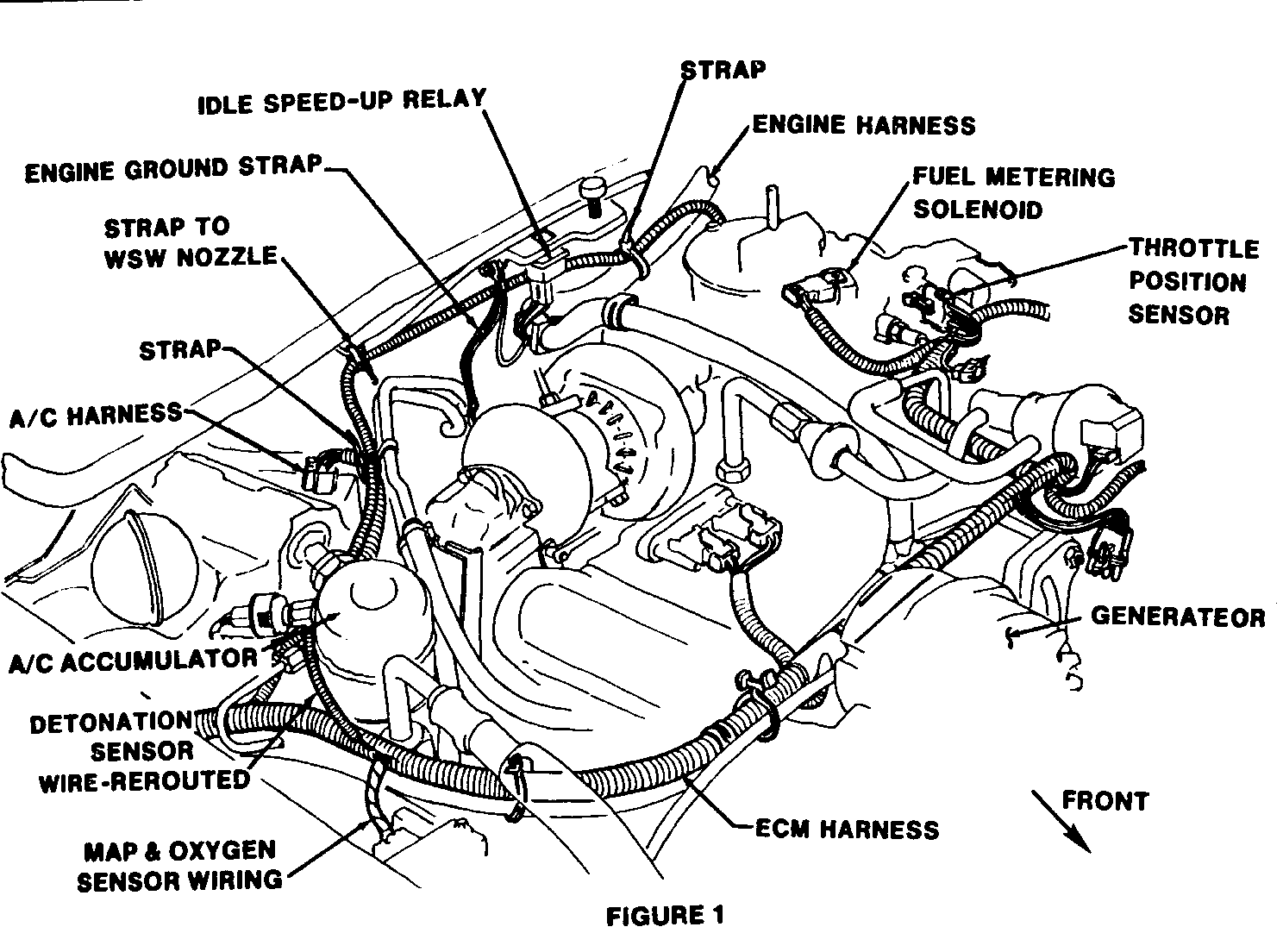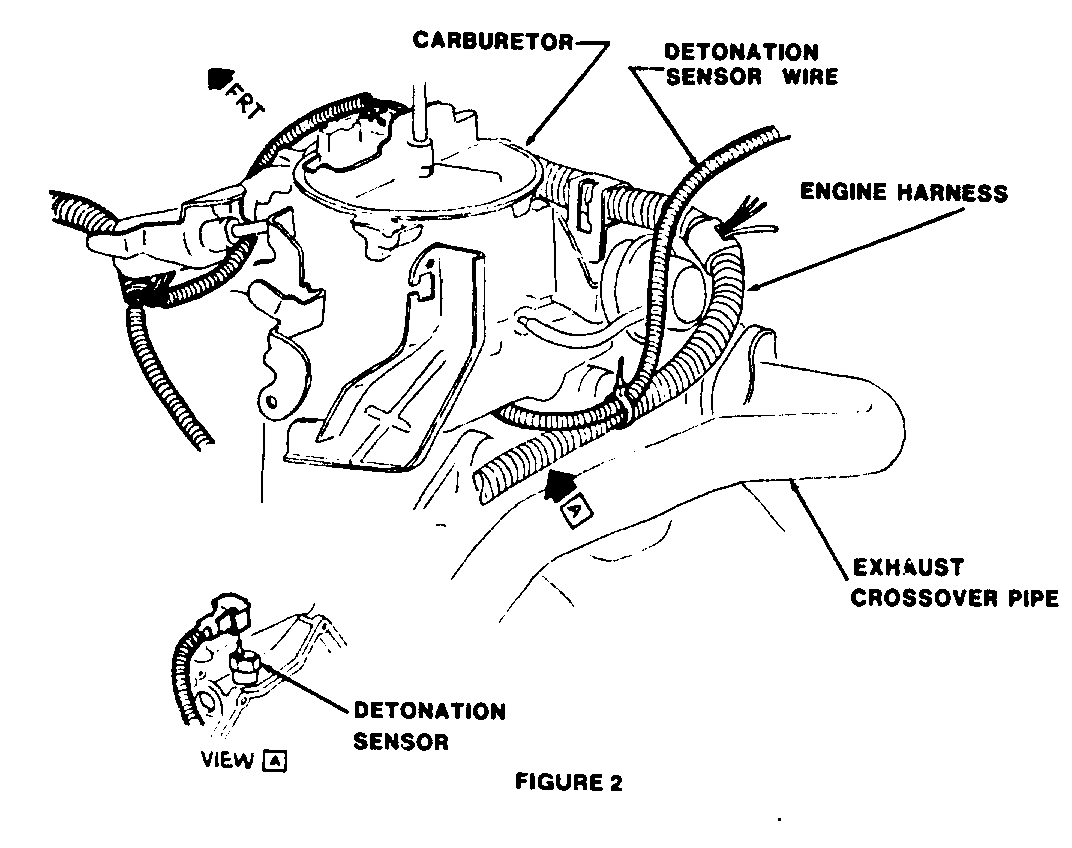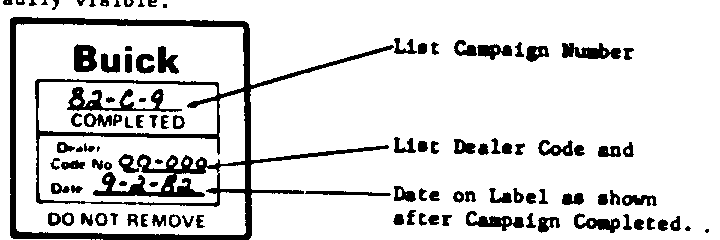CAMPAIGN: ESC DETONATION SENSOR WIRE ROUTE PROBLEM

MODELS AFFECTED: 1982 Rivieras Equipped With Turbocharged (LC8) Engines
General Motors has determined that some 1982 Rivieras equipped with turbocharged (LC8) engines have the Electronic Spark Control (ESC) detonation sensor wire routed too close to the distributor and spark plug wires. This condition may cause "false retard" of the ignition system resulting in poor driveability and/or performance.
To prevent this possibility, the ESC detonation sensor wiring is to be rerouted and protective conduit installed on all vehicles involved as instructed in the Technical Procedure of this bulletin.
VEHICLES INVOLVED
1982 Rivieras equipped with turbocharged (LC8) engines with serial numbers from CE400001 through and including CE441701.
DEALER ACTION
Dealers are to perform this recall campaign at no charge to the owner on affected vehicles, regardless of time, mileage or ownership, and are to correct all affected vehicles in dealer new and used car inventory prior to their sale.
Whenever a vehicle subject to this campaign is taken into your new or used car inventory in the future, you should take the steps necessary to be sure the campaign correction has been made before reselling the vehicle.
Dealers are to perform the campaign services on all affected vehicles as they are brought in for any kind of service until all affected vehicles have been corrected.
DEALER MATERIAL AND PARTS INFORMATION
If your dealership has vehicles involved in this campaigns you will receive the following items:
List of all vehicles involved in this campaign shipped to your dealership.
One 82-C-9 Kit furnished "NO CHARGE" for each of your vehicles involved.
This kit includes:
1 - 30" section of plastic conduit. 3 - retaining straps 1 - campaign identification label
Additional kits are available from your Buick Zone Office.
Involved vehicles are identified on computer listings. Computer listings contain the complete Vehicle Identification Number, owner name and address data, and are furnished to the involved dealers with the campaign bulletin. Owner name and address data furnished will enable dealers to follow up with owners involved in this campaign.
The computer listings may contain owner names and addresses obtained from State Motor Vehicle Registration Records. The use of such motor vehicle registration data for any other purpose is a violation of law in several states. Accordingly, you are urged to limit the use of this listing to the follow-up necessary to complete this campaign. Any dealer not receiving a computer listing with the campaign bulletin was not shipped any involved vehicles.
TRANSFER OF VEHICLE
If a vehicle on your list is not in your area, forward campaign kit and vehicle information for this vehicle to your Buick Zone Office for handling with the proper dealer.
OWNER NOTIFICATION
Owners of vehicles involved in this campaign, whose addresses are known. will be notified by Buick Motor Division. A sample owner letter is included in this bulletin.
TECHNICAL PROCEDURE
NOTICE: The detonation sensor wiring referred to in the following procedure may have been routed down the left side of the engine or down the center of the engine. The location of the sensor wire should be determined prior to performing the modification.
1. Raise hood and disconnect negative battery cable.
2. Remove approximately 100mm (4") of wiring harness from ECM harness conduit at point where MAP and Oxygen sensor wiring enter conduit (located near MAP sensor on right side wheel house panel). Remove plastic tape from harness to gain access to wirlng. Refer to Figure 1.
3. Isolate the three light blue wires from harness and identify detonation sensor lead by pulling on each wire individually. If unable to determine lead in this fashion, use continuity light and process of elimination on the three wires. Refer to Figure 1 and Figure 2.
*Light blue wires represent leads to the following:
1. Detonation sensor
2. Fuel metering solenoid
3. Throttle position sensor
4. Cut detonation sensor wire is close as possible to ECM harness. Cut should be made towards detonation sensor end of wire to allow for splicing in Step 11.
5. Remove detonation sensor wire from harness by pulling wire through harness from sensor connector end. Do not disconnect wlre from sensor.
CAUTION:
Use care not to contact hot parts.
6. Cut approximately 200mm (8") from end of loose detonation sensor wire.
7. Add additional conduit furnished with 82-C-9 kit to wiring for protection, trim to required length and tape to existing conduit on wire. Use black electrical tape.
8. Route wire behind idle speed up relay and rearward of engine ground strap so that wire is up against front of cowl. (See Figure 1).
9. Using furnished straps, secure sensor wire to engine harness directly behind carburetor to metal pipe part of windshield washer nozzle and at A/C harness behind conduit clip at end of A/C harness.
NOTICE: Be sure detonation seneor wire is not touching exhaust cross over and is secured firmly enough to prevent its working down onto the cross over from road shock or vibration.
10. Route sensor wire along A/C harness and between accumulator and heater blower motor housing.
11. Strip sensor wires (end from sensor and end remaining in ECM harness) and solder together using rosin core solder.
12. Apply RTV sealer, part number 1052366 or equivalent, to spliced area to prevent possible entry of water and apply black electrical tape to cover splice. Also tape any wires pierced in Step #3 in checking continuity.
13. Retape wliring harness (removed in Step #1) and place all removed wires in ECM harness condult. Tape conduit closed to prevent reopening.
14. Install Campaign Identification Label.
Each vehicle modified in accordance with the introductions outlined in this "Technical Procedure" will require a campaign identification label. Each label provides a space to include the campaign number, the five (5) digit Dealer Code of the dealer performing the campaign service, and the date vehicle was campaigned. This information may be inserted with a typewriter or ballpoint pen. When installing label, clean the surface of the radiator upper mounting support and apply the campaign label where it is readily visible.
WARRANTY INFORMATION
Dealers are to submit each campaigned vehicle as a separate case on the one-line warranty document, Form S-764. Dealers submitting warranty claims by teletype terminal are to transmit completions as a separate case.
SUBLET PART FAILED PARTS FAILURE LABOR LABOR OTHER DEALER OPERATION COUNT PART NO ALLOW CODE OP NO HOURS HOURS MTL TWG
Reroute ESC * ** sensor wiring 96 V1320 .6 hr .1 hr $.18
*.1 hour for Administration
**$.18 is for 30% of dealer price of furnished conduit.
To assure accurate records of all transactions on this Campaign, it is recommended that Campaign repairs for each vehicle be listed on a separate repair order. Other repairs performed to the vehicle may be listed on the same repair order; and warranty, other than Campaigns, may be listed on the same warranty document.
Warranty documents on this Campaign are not to be sent to the Zone Office. Send directly to Buick, Flint, as is done with normal submissions of warranty documents.
Zone authorization is not required.
Dear Buick Owner:
General Motors has determined that some 1982 Rivieras equipped with turbocharged engines have the Electronic Spark Control (ESC) detonation sensor wire routed too close to the distributor and spark plug wires. This condition may cause "false retard" of the ignition system resulting in poor driveability and/or performance.
To prevent this possibility, the ESC detonation sensor wiring is to be rerouted and protective conduit installed by your Buick dealer at no charge to you. Parts are available. Please contact your dealer to have this service performed.
Instructions for making this correction have been sent to your dealer. The time required to perform the labor to make this modification is approximately 30 minutes. Please allow additional time for the dealer to process your vehicle.
The enclosed owner reply card identifies your vehicle. Presentation of this card to your dealer will assist them in making the necessary correction to your vehicle in the shortest possible time. If you have sold or traded your vehicle, please let us know by completing the postage paid owner reply card and returning it to us.
We are sorry to cause you this inconvenience; however, we have taken this action in the interest of your continued satisfaction with our products.



General Motors bulletins are intended for use by professional technicians, not a "do-it-yourselfer". They are written to inform those technicians of conditions that may occur on some vehicles, or to provide information that could assist in the proper service of a vehicle. Properly trained technicians have the equipment, tools, safety instructions and know-how to do a job properly and safely. If a condition is described, do not assume that the bulletin applies to your vehicle, or that your vehicle will have that condition. See a General Motors dealer servicing your brand of General Motors vehicle for information on whether your vehicle may benefit from the information.
